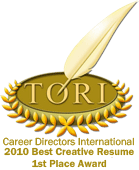There are two reasons keywords can be important in your resume:
1. There are some employers scanning resumes with Applicant Tracking Systems (ATS) before sending them to human readers. ATS is looking for keywords.
2. People are often in a hurry. Most appreciate well organized material with skimmable lists.
A keywords list fits both criteria.
Where to find keywords
Look for keywords first in the job description of the position you want. Think like the hiring manager or human resources person who wrote the list of keywords and job posting. Which words describe what they’re looking for in an employee? Which of those apply to your skills and knowledge? Those are your keywords.
If you still don’t have a clear picture of the duties, visit ONET. In the upper right corner, key the name of the position you want in the Occupation Quick Search field and click the arrow. You will see a list of links to jobs in relational order to the title you typed in. Click on the one closest to what you’re looking for. The description you see will be much more comprehensive than the job description in the job posting. You may find more keywords to match with your qualifications. List those with the ones you found before. List as many as you find. We’ll narrow the list next.
Which words to use
Again, make sure each word you have chosen is within your area of expertise or knowledge. If in doubt, choose a better word or omit the term altogether.
Choose hard skills over soft skills and attributes. For example, “Strategic Planning” is a better keyword than “Organizational Skills.” Note that keywords are often key phrases but that they need to be short and precise.
Make all of the keywords nouns or noun phrases. For example, use “PC Repair” rather than “Repair PCs.”
Be as specific as possible. “Excel” is better than “Spreadsheet Program.”
How to list keywords
Use no more than 21 keywords in a list. I prefer about 15.
Avoid the use of tables and text boxes to organize keywords because they are often omitted from ATS scans, the very reason we are using them.
Instead, use tabs to place your keywords in three columns across the page.
1. First type a heading such as Core Competencies, Knowledge and Expertise, or Value Offered.
2. Leave a vertical space, and then type your 15 to 21 keywords in one column.
3. Highlight the entire column without the heading and place a left tab (looks like a capital L) at 0 on the left margin.
4. Place a center tab (looks like an upside-down capital T) at 2.5 inches, and a left tab at 4.5 inches.
5. Unhighlight the column.
6. Note the length of each keyword or phrase and place the longest phrases in the center column.
7. Place the shorter words and phrases in the left and right columns.
8. If the words don’t fit in the column, try rearranging them or think of a shorter phrase. Be careful, however, that you don’t lose the searchability. If the company used the words in the job description, they’ll probably use them in the ATS scan.
Where to use the list
The list will appear in your resume immediately following the introductory qualifications paragraph and immediately before your Experience category.








